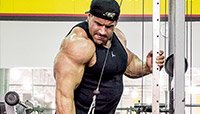Part 1 | Part 2
The main concern in losing weight is the "losing weight" word itself. People only want to weigh less on the scale. That's not a hard task to achieve. Anybody can tell you, "Just eat less calories than you consume and that's all"!
By doing that of course you will lose weight, but you won't ever be in shape. Sound strange? It may, but it isn't! It's science! If you want to get defined, the first thing to do is to forget about losing weight!
Your weight is the total sum of 2 components:
- Fat Free Mass (FFM)
- Fat Mass
The FFM consists of bones, skeletal muscles, and non-skeletal muscles.
Looking at the FFM from a chemical point of view it contains 19.5% of proteins, 72.4% of water, 8% of skeletal minerals and 0.1% of glycogen.
Weight can also be lost by decreasing the FFM. When a person loses weight in this case, they are still considered fat and are not good to look at. The only way to be defined and reach that goal is by decreasing the fat mass while keeping the FFM (muscle, etc) as high as possible.
This task is hard to achieve for a variety of reasons, including: scientific knowledge on nutrition & training, time, and sacrifice.
What To Do
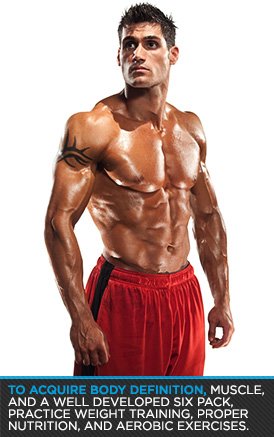
To have the whole body defined, muscular and of course, also have a well developed six pack, weight training, proper nutrition, and aerobic exercises are needed. In this article I will focus on aerobic exercise.
Weight Training is necessary for 2 main reasons:
Aesthetic Reason - Building muscle is important for giving a muscular and hard look to the body once definition is reached.
Physiological Reason - By increasing the lean muscle mass and thus the size of the muscle cell, you will also increase the number of cellular organelles named Mitochondria, who are the energy centers of the cell. Inside the Mitochondria, the oxygen is burned in order to produce energy to sustain the aerobic metabolism, the one that uses fat as fuel for energy. It is obvious that the more Mitochondria you have, the more oxygen is used and the more fat stored in adipose tissue is burned while doing aerobic exercise. Yes!
Further more, in a well weight trained physique there's an increase in the intracellular bio-availability of the enzymes of beta oxidation, krebs (or citric acid) cycle and transport chain electrons. A proliferation of capillaries will also occur, generating more transportation of nutrients as well as oxygen to the peripheral districts, which in turn means faster oxidation.
Nutrition
Nutrition is probably the most important key from which the effectiveness of a proper weight and aerobic training depends on. Since nutrition is a complex field and most of it depends on the hormonal responses to eating, it needs to be discussed apart in a whole different article.
Aerobic Exercise
Aerobic exercise (jogging, treadmill, bicycle, etc.) is critical for losing body fat, especially for those who aren't blessed by great genetics.
Jogging, running on the treadmill, bicycling, etc, doesn't mean that you are exercising at aerobic rate just because those activities are commonly known to be "aerobic".
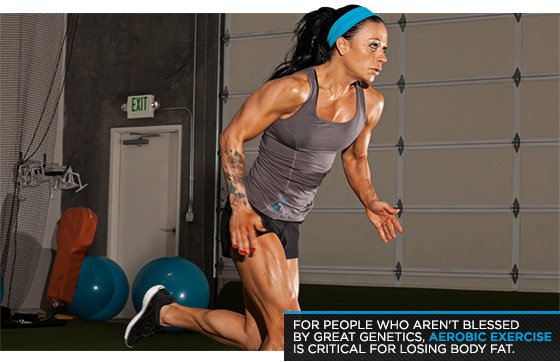
Aerobic means that your cells are using oxygen to produce energy. Aerobic means that all the energy needed to sustain that kind of physical effort comes from oxidative processes.
When you exercise you are increasing the need of oxygen intake to your muscles, so that your heart will pump faster in order to carry more blood (blood transports oxygen) to the muscular area exercised. But when the heart pumps faster than the rhythm of the lungs this condition cannot be satisfied.
In order to satisfy that condition, the heart and lungs have to work at the same rhythm so that all the oxygen taken from the atmospheric air by the lungs can be pumped by the heart to the peripheral areas.
In order to promote those requirements, aerobic activities have to be led in a limited heart rate zone.
The ideal heart rate zone favorable to promote fat loss ranges around 65-70% of maximum heart rate.
The most common calculation used to calculate one's maximum hearth rate is 220-age.
There are two different ways to calculate your maximum heart rate and your target heart rates. The method I just explained is the simple method. Read the full article about heart rate zones here.
Simple Target Heart Rate Calculator
Using the 220 - Age formula.
The Karvonnen formula is more advanced since it also takes into account your resting heart rate. This is your heart rate at complete rest. To determine this, take your pulse for 60 seconds just before you get out of bed... or take it for 30 seconds and multiply by 2.
Advanced Target Heart Rate Calculator
Using the Karvonen Formula.
- For your age, use a whole year. (Between 0 and 100)
- Put your Resting Heart Rate in the next box. (Between 30 and 100)
- In the % box, use a number between 50 and 85. Do not include the %.
- Click on the "Calculate" button, and it will calculate your target heart rate or that percentage.
An example of a fat loss aerobic exercise program is:
aerobic exercise program schedule |
||
| Week | How Many Times A Week? | Minutes Of Aerobic @ 65-70% MHR |
| 1 | 3 | 30 |
| 2 | 3 | 45 |
| 3 | 3 | 40 |
| 4 | 3 | 45 |
| 5 | 4 | 35 |
| 6 | 4 | 40 |
| 7 | 4 | 45 |
| 8 | 5 | 40 |
| 9 | 5 | 50 |
| 10 | 5 | 55 |
It doesn't matter if you do aerobic exercise on a treadmill, biking or jogging etc., it's up to you. If you are too heavy and it may put a lot of stress on your knees and ankles, I suggest you try biking or the elliptical trainer.
Adapting
For those who are newcomers to aerobic exercise, it will be difficult to train at the ideal heart rate zone because of the lack of training-induced bradicardical adaptations. Start slow and work up. After a few days (depending by one's physical condition) this adaptation occurs and there will then be no difficulty in training at the fat-loss heart rate zone. You can do it!
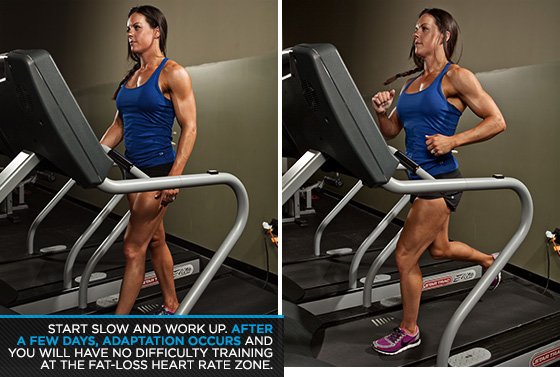
What we looked at so far is only the optimum heart rate zone to work at. But another important factor is the exercise duration; in fact, in the initial phases of aerobic training the major source for energy production is glycogen (glucose stored into muscle tissue). The longer the low intensity aerobic exercise lasts, the more the body will be forced to use fat metabolism rather than glucose metabolism.
The energy requirements during low intensity, long duration aerobic activities are mostly linked to fat metabolism, in fact it happens that fatty acids are released from the triacylglycerol molecule. The fatty free acids (FFA) are transported into the bloodstream linked to a plasmatic protein and thus are used by the muscles as energy substrate.
In fact, once aerobic activity has begun, a reduction in FFA plasmatic concentration occurs because of a major FFA consumption from the muscles. Afterward an increase in the sympathetic tone (induced by physical exercise) will induce a release of the Adrenaline hormone from the suprarenal glands. A glycemic drop will also occur generating the secreting stimulus for glucagon incretion.
These two hormones will increase the formation of cyclic AMP in the cells which is in turn a compound that through a different chemical reactions will promote glycogenisis as well as FFA releasing from the triacylglycerol molecule stored in the adipose tissue.
Of course our attempt is to promote fat releasing for energy production rather than glycogen breakdown. Since glycogen is the main source we have for energy production when oxygen is not available into the muscle, all we have to do is to assure the muscle the right oxygen uptake; this is a condition that can be greatly satisfied when exercising at the proper heart rate zone.
Fat-burning Process
In order to optimize the fat-burning process, particular endogenous hormonal responses have to be elicited. The main hormones that control the fat storing process into the adipose tissue and fat releasing process from the adipose tissue are: Insulin for the former and glucagon for the latter purpose.
- Insulin is secreted from beta cells of the liver.
- Glucagon is secreted from alpha cells of the liver.
- They have opposite biological functions.
- If one is secreted, the opposite hormone secretion is inhibited and vice versa.
- Insulin secreting stimulus is blood glucose.
- Glucagon secreting stimulus is hypoglycaemia (low blood glucose).
As a matter of fact, obviously, doing aerobic exercise when glucose levels are low greatly promotes fat-burning for energy production. Timing is very crucial on for this purpose. The typical question is, "Won't this condition lead to dizziness and will I be able to go through exercising while on hypoglycaemic condition"?
In such cases, there's no reason to worry about that because if the aerobic activity is kept in the favorable heart rate zone, all the energy needed will NOT come from stored glycogen but from fatty acids stored in the adipose tissue (and fat stores are unlimited even in the leanest people, so that energy production from that substrates is always assured). In order to create the right condition (hypoglycaemia) to begin aerobic and thus for optimizing the fat-burning process there are two main ways:
First in the morning: The lack of food consumption for several hours (6-9 hours) from the last meal, insulin levels are fairly low so the insulin cannot act as lipogenic and thus glucagon is readily secreted from the very initial phases of aerobic exercise promoting lipolysis.
Right after weight training: Weight training leads to insulin inhibition and glucagon and catecholamines incretion. By creating this condition, aerobics will work successfully.
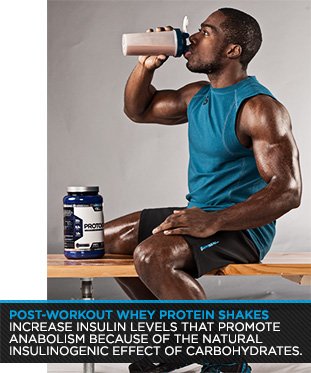
I strongly recommend aerobics first in the morning rather than after weight training for one important reason:
After an intense workout structured for muscle growth, muscular glycogen needs to be replenished as soon as possible with a high quality post-workout beverage. As a matter of fact, this period of time (30 minutes) after weight training is very critical because it's the most anabolic / anti-catabolic phase of the day. Use it or lose it!
This time is very crucial because the nutrients contained in a proper post workout shake will increase insulin levels that will promote anabolism because of the natural insulinogenic effect of carbohydrates combined with a fast protein like whey isolate. Whey isolate is pretty much anabolic to induce dramatic glucose and amino acid uptake in muscle tissue.
High Insulin Levels
Furthermore high insulin levels induced by your post-workout meal will block the excretion of cortisol (which is well known to promote glycogenolysis, a process by which structural proteins are broken down into amino acids and transformed into glucose) stimulated during physical and emotional stresses (e.g. weight training).
Missing this post-workout shake will make your body avoid muscle anabolism and it will not block muscle catabolism. That's what could happen by doing aerobics in the 30 minutes following weight training instead of drinking the anabolic workout shake. If aerobics are done first thing in the morning, these things not possible for several reasons. So I recommend that you consume the right amount of BCAAs after weight training and prior to begin aerobics. From my personal experience, if aerobics are done after weight training, my advice is to avoid going over a 30 minute period.
Conclusion
These advices are totally derived from scientific knowledge on physiological hormonal responses to food consumption and training, therefore if applied with the right personal adjustment are supposed to help you get RIPPED TO SHREDS!
Part 1 | Part 2
Recommended For You
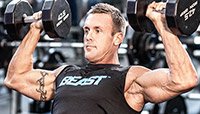
Brandan Fokken's Mile-Wide-Shoulder Workout
HThe human body isn't stubborn. It's obedient. It does what you tell it to. It changes when you want it to. With the right tools, you can build the body you want.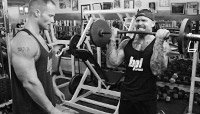
Blast Your Back And Biceps!
Build a burly back and powerful biceps with this video workout from James Grage and Whitney Reid! This is the back workout you've been missing.